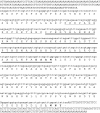Cloning and characterization of cold, salt and drought inducible C-repeat binding factor gene from a highly cold adapted ecotype of Lepidium latifolium L
- PMID: 24431489
- PMCID: PMC3656188
- DOI: 10.1007/s12298-012-0154-2
Cloning and characterization of cold, salt and drought inducible C-repeat binding factor gene from a highly cold adapted ecotype of Lepidium latifolium L
Abstract
The dehydration-responsive element-binding (DREB) protein/C-Repeat Binding Factors (CBFs) belongs to APETALA2 (AP2) family transcription factors that binds to DRE/CRT cis-element in cold-responsive (COR) genes and induce COR genes. CBFs have been isolated and characterized from evolutionarily diverse plant species. CBF pathway is conserved by CBF regulon and the size or the number and kind of target genes vary among freezing sensitive and tolerant plants. Hence, cloning of CBFs from highly freezing tolerant plants such as Lepidium latifolium L. will be useful in understanding the freezing tolerance of this species. In this study, LlCBF, a CBF1 family gene from L. Latifolium L., was cloned using RT-PCR and RACE-PCR. The full length mRNA of LlCBF is 948 bp with an open reading frame of 642 bp, encoding a protein of 213 amino acids with a molecular weight of 23.92 kDa and a theoretical isoelectric point of 4.80. Amino acid sequence analysis showed that LlCBF has an AP2 DNA binding domain, a potential CBF type nuclear localization signal (NLS) and C-terminal acidic domain. Semi-quantitative RT-PCR analysis of LlCBF revealed that this gene is up-regulated by high salt, dehydration and low temperature stresses. The investigation is therefore successful in cloning of a gene having strong homology with CBF transcription factors and responsive to low temperature, high salt and dehydration conditions.
Keywords: Cold; Lepidium latifolium L.; LlCBF transcription factor; Salt and drought inducible.
Figures





References
-
- Aslam M, Sinha VB, Singh RK, Anandhan S, Pandey V, Ahmed Z. Isolation of cold stress-responsive genes from Lepidium latifolium by suppressive subtraction hybridization. Acta Physiol Plant. 2009;32:205–210. doi: 10.1007/s11738-009-0382-4. - DOI
LinkOut - more resources
Full Text Sources
Other Literature Sources
Research Materials
